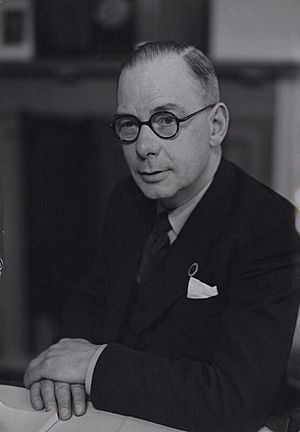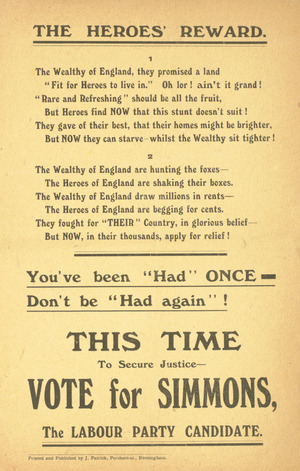Charles Simmons (politician) facts for kids
Quick facts for kids
Charles James Simmons
|
|
|---|---|
 |
|
| Member of Parliament for Brierley Hill |
|
| In office 23 February 1950 – 18 September 1959 |
|
| Preceded by | Constituency established |
| Succeeded by | John Ellis Talbot |
| Member of Parliament for Birmingham West |
|
| In office 5 July 1945 – 3 February 1950 |
|
| Preceded by | Walter Higgs |
| Succeeded by | Constituency abolished |
| Member of Parliament for Birmingham Erdington |
|
| In office 30 May 1929 – 7 October 1931 |
|
| Preceded by | Arthur Steel-Maitland |
| Succeeded by | John Eales |
| Personal details | |
| Born | 9 April 1893 Moseley, Birmingham, England |
| Died | 11 August 1975 (aged 82) |
| Political party | Labour |
Charles James "Jim" Simmons (born 9 April 1893 – died 11 August 1975) was an important British speaker, writer, and politician. He spent many years working to help people, especially those who had served in wars.
Contents
Early Life and Wartime Service
Jim Simmons was born in Moseley, a part of Birmingham, England. From a young age, he was very active in his church. At just 16, he became a lay preacher, which meant he could give sermons and lead services.
When World War I started, Jim joined the Worcestershire Regiment. He fought in different places like France, Egypt, and Gallipoli. During his time in the army, he was put in prison twice. Once was for speaking out against harsh punishments given to soldiers. The other time was for wearing his army uniform at a peace rally, showing he believed in peace even during wartime.
Jim was hurt three times during the war. The last time was at Vimy in 1916, where he was so badly injured that his lower leg had to be removed. He left the army in November 1917. Even after his injuries, he kept working for peace. However, in February 1918, he was arrested again and spent three months in Armley Gaol (a prison).
A Voice for Veterans
After World War I, Jim became a key member of the National Union of Ex-Servicemen (NUX). This was a group that worked to get better rights and support for soldiers returning from the war. Even after the NUX stopped being a big national group, Jim continued to help veterans in his local area.
Later, when he became a Member of Parliament, he strongly supported the British Limbless Ex-Servicemen's Association (BLESMA). This group helps veterans who have lost limbs. Jim was also a Christian Socialist, meaning he believed in using Christian values to create a fairer society. He was also involved in the Labour Church movement, which combined religious ideas with workers' rights.
Jim first entered politics by becoming a member of the Birmingham City Council. He served there from 1921 to 1931 and again from 1942 to 1945.
Becoming a Member of Parliament
A Member of Parliament (MP) is a person elected to represent a group of people in the country's main law-making body, called Parliament. Jim Simmons wanted to be an MP to help more people.
Representing Erdington
In 1924, Jim Simmons ran for Parliament in the Birmingham Erdington area as a candidate for the Labour Party. He tried to win against the sitting MP, Sir Arthur Steel-Maitland from the Conservative Party, but he did not win that time.
At the next general election in 1929, Jim ran for Erdington again. This time, he won! He beat Steel-Maitland by a very small number of votes, only 133. Another candidate, H J H Dyer, also ran and received many votes, which helped Jim win. The election was very competitive. Jim had accused Steel-Maitland of misusing his position as Minister for Labour. After Steel-Maitland threatened to take legal action, Jim formally apologized.
Just two years later, in 1931, another election was held. Jim tried to keep his seat against a new Conservative opponent, J F Eales. Many people voted against the Labour Party that year, and Eales won by a large number of votes.
Jim tried to win the Erdington seat back from Eales in the 1935 election, but he was not successful. He also ran in a special election in 1936 after Eales died, but he lost again. This was the last election until 1945 because of the Second World War. During this time, Jim worked as a political journalist. He edited a newspaper called Town Crier from 1940 to 1945.
Serving Birmingham West
In the 1945 general election, Jim Simmons was chosen to run for the Labour Party in Birmingham West. He ran against the Conservative MP Walter Higgs. This election was a huge victory for the Labour Party across the country, and Jim won his seat easily.
After winning, he took on important roles in the government. From 1946 to 1949, he was a Lord of the Treasury, which is a government position that helps manage money. After that, he became the Parliamentary Secretary to the Minister for Pensions, helping with issues related to pensions for people.
MP for Brierley Hill
Because of changes to the election areas, Jim became the MP for a new area called Brierley Hill in 1950. He won this seat again in the 1955 election. However, in the 1959 election, he was unexpectedly defeated by his Conservative opponent.
Jim was a strong supporter of the Temperance movement, which encouraged people to avoid alcohol. He also campaigned for children under 14 to be banned from the bar areas of clubs. Some people believe that his strong views on these topics, especially his stance on alcohol, might have contributed to his defeat in 1959.
Later Life
In 1972, Jim Simmons wrote a book about his life called Soap-Box Evangelist. He passed away in 1975 at the age of 82. He was survived by his four sons and his second wife.


